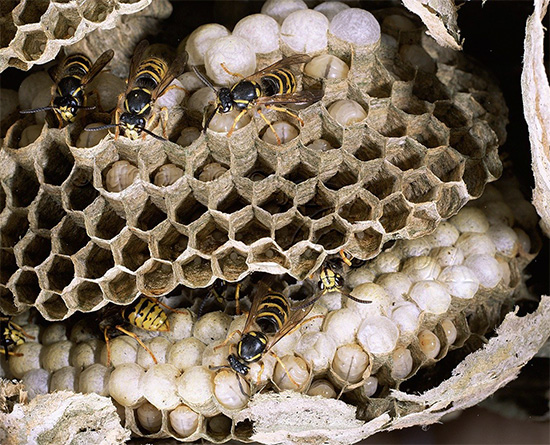
Wild wasps are the common national name of all wasps that build their nests away from human buildings. However, by and large, almost all of these insects can be called wild, including several types of paper wasps, which sometimes tend to settle close to human habitation, where they find plenty of food.
Sometimes ordinary hornets also settle in the suburban areas and in houses. But it happens much less often, and in general hornets are typical large forest wasps settling among abundant foliage of trees or in dense bushes.
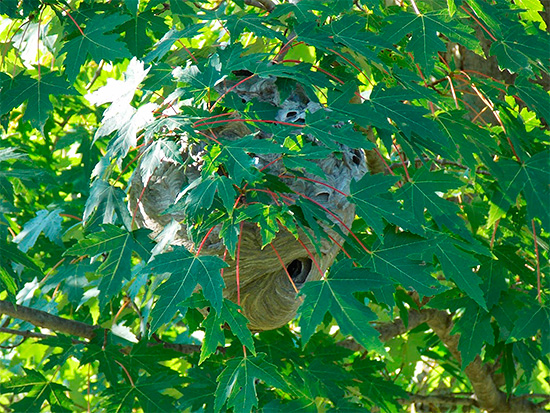

But not everything is so simple in the aspen kingdom: many wild wasps live in gardens and gardens, in front gardens and flower beds right next to the houses, the larvae of which develop twenty to thirty centimeters under the surface of the earth, and their parents bustle around our feet, getting food for their offspring. These insects are not striking us and are often not perceived even as wasps just becausethat not all of them have a characteristic yellow and black striped coloring and, moreover, many of them lead a solitary lifestyle and are never so numerous as to cause inconvenience with their presence.
However, solitary wild wasps may attract attention. For example, the photo below shows a giant scolium, one of the largest European wasps. Such a large black insect simply cannot fail to draw a look to itself:

Another example is the shiny wasps, which are striking primarily due to their unusual bright color. However, only a person who is well versed in biology identifies them as wild wasps:
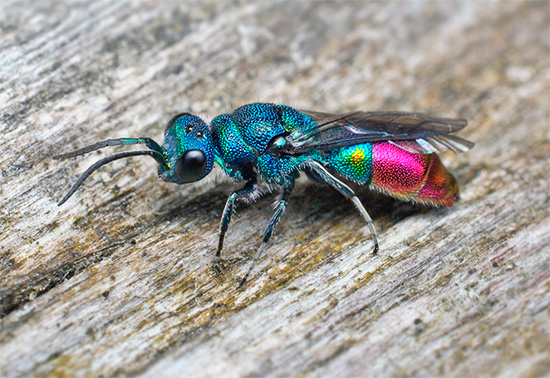
Public wasps: how they look, where they live and what they feed on
Public wild wasps are the most famous and easily recognizable. That they usually have in mind when talking about "wild wasps." This group includes several families, for example:
- polish wasps, to which the well-known yellow and black paper wasps belong (in general, the family has several hundred species, but only 2-3 of them are familiar human neighbors);
- Vespina wasps (in other words, hornets) are the largest public wasps and one of the largest representatives of wasps in general;
- polybine wasps are American "analogues" of European paper wasps.


The main feature of all types of social wasps is that they live in large families, in which the eggs are laid by one female, called the uterus, and take care of the offspring, get food and protect the nest for several dozen or hundreds of working individuals.
It is interesting
All working wasps in the family are females incapable of breeding. Their lifetimes range from a few weeks to a few months, and they usually do not survive the winter.
Solitary wasps, fearless and unobtrusive
If public wasps are known for catching and carrying various insects in the nest (sometimes even quite large ones), then single wasps literally amaze with their fearlessness in catching food for the larvae. Many of their species catch poisonous spiders (and some even specialize only in tarantulas or solpugs), as well as bedbugs, praying mantis, bees.

The victim is paralyzed by the prick of a sting and is taken to a previously prepared mink in the ground, where an egg is laid on her immobilized but still living body. Further developments are even less obvious: the larva hatching from the egg bites into the body of "canned food" and begins to eat it methodically.
In the first place, prey eats up those organ systems, the loss of which will not lead to the instantaneous death of the immobilized insect - the larva begins its feeding from the victim's digestive, excretory and sexual systems, and only at the end of its development does it pass to the respiratory and nervous systems. This “approach” allows you to keep a stock of fresh meat for the longest possible time.
Single wasps are markedly different from the public constitution and color. They usually have a long slim body and dark colors. However, among them there are brightly colored species. For example, the bee wolf is a philanthropist, which is very similar in color to paper wasps:

Some road wasps have an overly elongated body, and some shiny wasps are so brightly colored that they can compete with butterflies in their beauty of appearance:
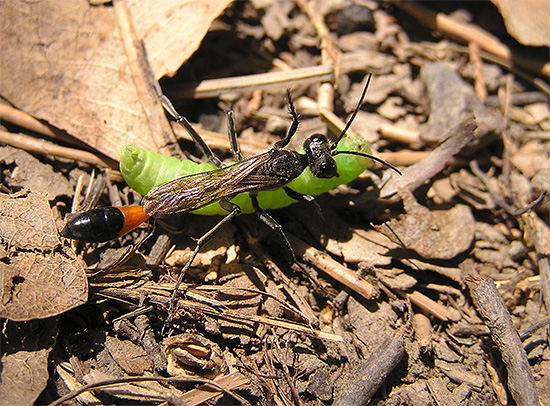

Single wasps are also striking in their size. So, for example, some tropical species of skoli are the largest wasps in general.
In addition, the scoli are interesting in that they do not even build secluded minks for their larvae. Caring for their offspring is limited to finding large larvae of beetles in the ground, paralyzing them with their sting and putting them off to catch eggs.In the future, the wasp larva will eat the beetle larva right in its underground shelter.
There is also a very interesting group of German wasps, who parasitize in the nests of their public counterparts and lay eggs on larvae, for example, the same paper wasps. The females of many species of wasps-Germans do not have wings, and their body is abundantly pubescent - outwardly they resemble fluffy ants, which is why they are often called "velvet ants."

Reproduction of wild wasps, their places of settlement and way of life
A family of wild public lands usually settles in secluded forest shelters (hollows, burrows, in dense bushes), but it can, for example, choose rock crevices and other lonely places. Here, the queen-female begins to build a nest of paper-chewed bark of young trees, which is already completed by working individuals.
In large hornets the nest can be about a meter in height and about 70-80 cm in diameter.

The main purpose of the nest of wild forest wasps is to protect and provide the larvae with normal conditions for their development. The uterus places eggs in pre-prepared honeycombs, in which young larvae hang due to a special glue, and older offspring simply burst a honeycomb with their flanks and therefore does not fall out of it.


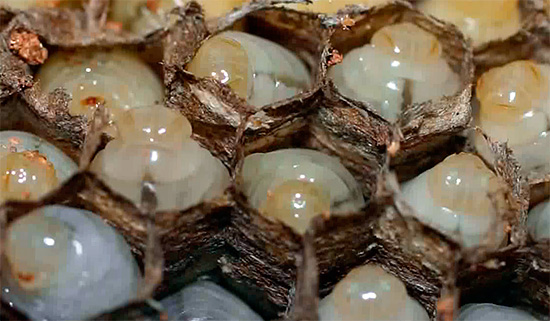
Adults of the public wild wasp feed on sweet fruits, nectar of flowers, fermented berries. But they feed their larvae exclusively with meat, a gruel of chewed insects.
By winter, the old queen dies, and the wasps of workers die. Only young females hide in hiding places for wintering, which next year will give rise to new families.
Unlike forest community counterparts, single wasps are less scrupulous about choosing a place to raise offspring - they arrange holes for their larvae literally everywhere. Some species even settle mainly along roadsides, where in an embankment it is very convenient for them to make houses for posterity. Minks of these insects can also be located in flowerbeds, in vegetable gardens, flower beds, in wastelands and just among the grass.
Adult single wasps do not survive the winter, and in the underground shelters among the remains of eaten prey, only pupae hibernate.
Why are wild wasps dangerous?
Virtually all wild wasps are capable of stinging quite painfully. At the same time, the strength of its bite and possible consequences for humans depend on the features of the biology of the insect:
- so, for example, it would seem that large and terrible scoliosis sting relatively weakly and practically without serious consequences, since their poison is primarily intended to immobilize the already inactive and harmless prey.
- But the poison of many species of hornets is so strong that it causes extensive swelling and a very sharp pain. Sometimes an allergic reaction to such a bite can lead to anaphylactic shock and death. Tropical huge hornets are especially dangerous in this regard - their multiple simultaneous bites can cause internal bleeding.

Feedback
“We had a story with hornets in the country. They settled right in the toilet, and when in the summer upon arrival, my husband and I decided to bring them out, so they attacked Seryoi with a whole swarm. He got 8 bites, it was impossible to look at him calmly. Such a feeling was that he swelled like a balloon, his eyes did not open and his nose did not breathe. It is good that a first-aid post is working in the partnership, there they gave him an allergy injection. Only this, probably, saved. I had to constantly give him painkillers because he couldn’t sleep at all because of the bites. ”
Hope, Moscow
Among the wasps there is an insect with one of the most painful bites in the world: the road wasp Pepsis elegans, the main part of the prey of which is tarantulas, is considered the second insect in the world because of the pain of a bite after a South American ant-bullet.
Wild wasps in the tropics
In tropical regions, wasps are more numerous than in Russia and other temperate countries. And there are widely represented both single and social species.
In the tropics of Thailand, India and Burma, the largest wasp in the world lives - Megascolia procer, which is 5.5 cm long. In China, Japan and Primorye, there are several species of huge hornets that have a body length of up to 5 cm and lead to a large number of deaths local population.


It is important to remember that when traveling in tropical countries should be prepared to meet with these insects and have the appropriate first-aid kit.
Feedback:
“We were driving in the afternoon on the road near Da Nang on a moped. Suddenly, I noticed a rapidly approaching spot and did not even have time to consider what it was like something soft hit my forehead and flew over my head. Almost immediately, I felt a terrible pain in my neck, as if a red-hot nail had been applied to it.It was so painful that I pulled my hand to the side of the neck, lost control and the moped flew into the ditch. Anya and I went down the road. Well, that she had a helmet.
I didn’t think anything then and just wanted to get rid of the terrible pain in my neck, but there was nothing there. When my friends drove up behind us, my neck was already swollen so that I could not turn my head and could hardly breathe. I hit hard when falling my head on the asphalt, but did not feel pain in my temple because of a bite. Friends said it was a local hornet and they immediately took Anya and me to the hospital. Some medicines were pricked for me there, and Anya was stitched onto a torn elbow. The swelling from the bite was gone only after two weeks. ”
Thomas, Vancouver
An interesting video: the owner of the site discovered a wasp nest in the ground and burned it out with a blowtorch
Potter wasp builds houses for its larvae



